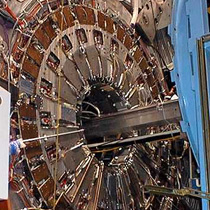Detection of Internally Reflected Cherenkov light (DIRC),
Particle Identification for BaBar
 The BaBar detector was built at Stanford Linear Accelerator Center to
study the millions of B mesons produced by the PEP-II storage ring. The
BABAR detector comprises the usual nested set of detector sub-systems to
precisely measure the collision point and decay points of the B-meson
pairs produced, the momentum and energy of the decay particles, and the
nature of the kind of particles in these decays (i.e. electrons, muons,
pions, kaons). An important issue in studying CP violation is the ability to tag decays
of b-quark versus b-antiquark mesons for particle momenta up to 2.5 GeV/c,
and to separate charged pions from charged kaons for momenta up to 4 GeV/c
in B decays. The driftchamber provides particle identification (PID) by
dE/dx measurements for tracks up to 0.7 GeV/c momentum. Dedicated PID
system (DIRC) for higher momenta.
The BaBar detector was built at Stanford Linear Accelerator Center to
study the millions of B mesons produced by the PEP-II storage ring. The
BABAR detector comprises the usual nested set of detector sub-systems to
precisely measure the collision point and decay points of the B-meson
pairs produced, the momentum and energy of the decay particles, and the
nature of the kind of particles in these decays (i.e. electrons, muons,
pions, kaons). An important issue in studying CP violation is the ability to tag decays
of b-quark versus b-antiquark mesons for particle momenta up to 2.5 GeV/c,
and to separate charged pions from charged kaons for momenta up to 4 GeV/c
in B decays. The driftchamber provides particle identification (PID) by
dE/dx measurements for tracks up to 0.7 GeV/c momentum. Dedicated PID
system (DIRC) for higher momenta.
The BaBar collaboration consists of around 600 physicists and engineers from 85 institutions in nine countries.
Collaborators
Collaborations based at the Stanford Linear Accelerator Center (SLAC) Stanford University, USA
Commissariat a l'Energie Atomic (CEA), DAPNIA-Saclay, Laboratoire de L'Accelerateur Lineaire (LAL) Orsay, LPNHE Paris VI et Paris VII, LPNHE de l'Ecole Polytechnique, France
Lawrence Berkeley National Laboratory,
University of California Berkeley, Rutgers University,
University of California Santa Barbara, University of Cincinnati, USA
Contact
Roy Aleksan
DAPNIA/SPP, Saclay, France
aleksan@dapnia.cea.fr
roy@slac.stanford.edu
http://www.slac.Stanford.edu/BFROOT
http://www-dapnia.cea.fr/Phys/Spp/
http://www.SLAC.Stanford.edu

